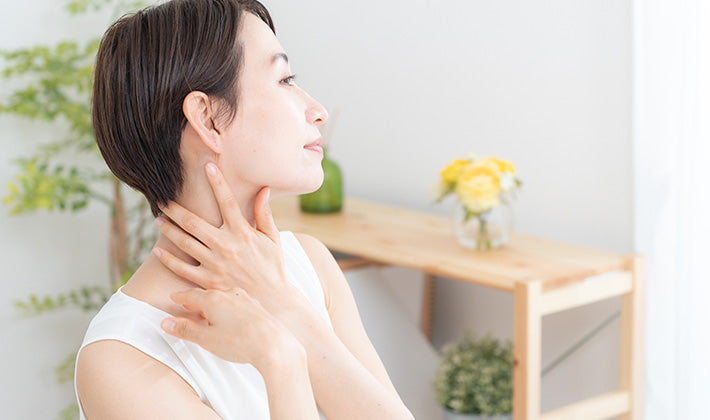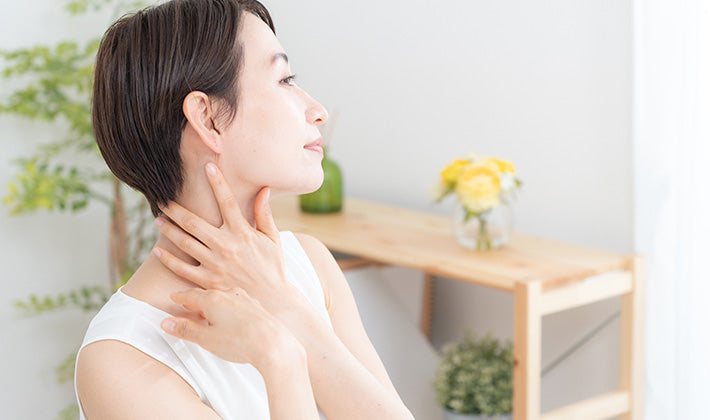
#Lymphatic Massage
2024/09/06
Learn Effective Lymphatic Massage Techniques to Relieve Puffiness, Dryness, and Tension!
Topic
What is the Role of the Lymphatic System?
The lymphatic system has two main roles: “immune function” and “excretory function”:
Immune Function
It helps remove viruses and bacteria from the body, primarily through lymph nodes located in the collarbone, neck, armpits, abdomen, groin, and knees.
Excretory Function
It collects old cells and waste, along with excess water, and transports them out of the body for elimination.
Signs of Lymphatic Congestion
When the lymphatic system is congested, old cells and waste cannot be effectively removed, leading to various symptoms:
Puffiness, Shoulder Tension, Cold Sensation
Congestion causes excess water, old cells, and waste to accumulate, resulting in puffiness. The legs, being farther from the heart, are prone to swelling due to poor blood flow and gravity. Shoulder tension can also indicate lymphatic congestion, especially from prolonged sitting or using a smartphone. Poor lymphatic flow affects blood circulation, making the extremities prone to coldness.
Lower Body Fat, Difficulty Losing Weight
Lymphatic congestion can also cause lower body fat and difficulty losing weight. Lack of exercise and dehydration lead to poor lymphatic and blood flow, making it hard for waste and excess water to be eliminated.
Constipation, Skin Problems
Lymph flow in the abdomen affects blood circulation, leading to decreased bowel function and constipation. Constipation can cause harmful substances to enter the bloodstream and spread throughout the body, leading to skin issues such as dryness and acne.
Benefits of Lymphatic Massage
Relieves Puffiness and Dry Skin
The lymphatic system lacks a pump and relies on surrounding muscles to facilitate flow. Gentle external massage promotes lymphatic and blood circulation, helping to reduce puffiness. It also aids in eliminating skin waste, gradually improving skin dryness and issues.
Improves Blood Flow and Relieves Shoulder Tension and Coldness
Lymphatic massage enhances both lymphatic and blood flow, helping to expel waste and improve overall circulation, thus relieving shoulder tension and coldness.
Eases Body Fatigue
Lymphatic massage helps remove fatigue-causing substances from the body, reducing overall fatigue. It also helps balance the autonomic nervous system and provides relaxation benefits.
Techniques for Lymphatic Massage by Body Part

Perform lymphatic massage in a relaxed state. Here are techniques for different body parts:
[Full Body] Start with the Feet
1. Massage the “Yongquan” Point on the Foot : Use your thumbs to press the “Yongquan” point on the soles of your feet to help with puffiness and overall fatigue. 
2. Massage from the Ankles to the Groin : Place your palms on your ankles and gently massage up the inner leg towards the groin, following the direction of lymph flow. Repeat on both legs.
3. Massage the Groin Area : Lie on your back and use your palms to massage the groin area from the outer side to the inner side. If the area feels tight, gently press with both hands to relax before massaging.
4. Massage the Neck : Start from behind the ears and massage downwards towards the shoulders. Then, massage from behind the ears to the collarbones. Finally, use your palms to gently massage along the jawline towards the lymph nodes under the ears to refresh the face area.
[Face] Start from the Front of the Neck
1. Massage the Front of the Neck : Use the palms of your hands to massage from the front of the neck towards the collarbones, applying gentle pressure and stretching your neck slightly.
2. Massage the Jawline : From the chin, massage along the jawline towards the area beneath the ears and the temples, using your palms to gently massage and warm the area.
3. Massage from the Nose to the Ears : Use the palms of your hands to massage from the sides of the nose to the cheeks and then to the ears.
4. Massage the Forehead : Place four fingers in the center of the forehead and draw small circles outward towards the temples.
[Collarbone] Start from the Side of the Neck
1. Massage the Side of the Neck : Use your palms to massage from below the ears to the shoulders.
2. Massage Above and Below the Collarbone : Use the pads of four fingers to massage the indentations above the collarbone first, then the area below the collarbone, moving from the outer side towards the inner side.
3. Massage from the Ear to the Armpit : Use the pads of your fingers to gently massage from beneath the ear, along the top of the collarbone, down to the armpit.
Key Points for Lymphatic Massage
Direction of Flow
The key is to massage in the direction of lymph flow, which is generally “from bottom to top” and “from inside to outside.” Lymphatic vessels have valves to prevent reverse flow, so follow the natural direction of lymph movement.
Pressure
Use gentle strokes for lymphatic massage. Lymph flows close to the skin surface, so light pressure is sufficient. Excessive force can cause pain or reduce effectiveness.
Speed
Massage slowly rather than quickly. Lymphatic flow is naturally slow, and quick movements may not be as effective. Aim for slow, gentle strokes to promote lymphatic flow.
Precautions for Lymphatic Massage
Avoid Massaging in Reverse
Lymph flows in one direction only. Massaging against this flow can cause waste and excess fluid to accumulate. Follow the correct flow direction.
Avoid Strong Friction
Massage should be gentle; strong friction can damage the skin or reduce effectiveness. Use creams, lotions, or massage oils to minimize friction and protect the skin.
By using the correct lymphatic massage techniques and appropriate moisturizers, you can effectively relieve puffiness, shoulder tension, coldness, and body fatigue, while also improving skin health.


